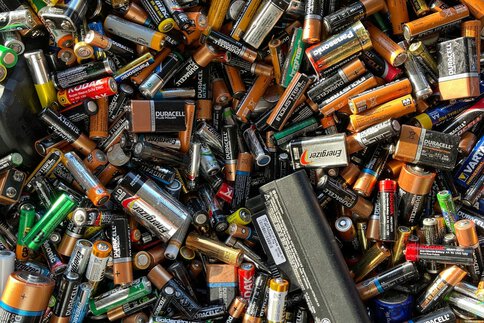Battery fires: a hot topic in waste management
Incorrectly disposed batteries cause fires in recycling and sorting plants, in garbage trucks and at recycling centers every day. An overview of the background and dimensions of the problem, as well as possible solutions.
In Germany, end users of batteries and battery-powered electrical and electronic devices are legally obliged to return them to the designated collection points. This can be done by using the battery collection boxes provided in shops for loose batteries and rechargeable batteries, or by handing them in at recycling and waste disposal centers or at the municipal hazardous waste mobile collection center. Old devices with built-in batteries are collected in separate containers at recycling centers, or can be returned to the store.
It is therefore prohibited to dispose of used batteries in household waste, for example. In practice, however, due to incorrect disposal or improper collection, batteries, accumulators and battery-powered appliances can be found in almost all fractions of municipal waste – from residual waste and commercial waste to waste paper and lightweight packaging. According to the reports of the German take-back systems, the collection rate for portable batteries in 2023 was 50.4 percent. Although this just exceeded the legally required minimum rate of 50 percent, it also means that half of all batteries were disposed of incorrectly.
More and more batteries in circulation
The growing use of versatile energy storage devices is also contributing to the scale of the problem: in comparison to 2012, the consumption of device batteries in Germany has increased by around 49 percent from 2022. Lithium batteries are becoming increasingly popular. In 2022, lithium-ion batteries accounted for around 27 percent of all batteries and rechargeable batteries sold in Germany. In addition, there are non-rechargeable lithium batteries, which account for a good three percent of the total battery market.
The market growth is driven not least by the trend towards the more or less sensible electrification of many everyday products: from flashing shoes and singing birthday cards to LED lights in bottle bottoms. One particularly problematic example of such products in this context is the popular disposable e-cigarettes. Around 80 million of the battery-powered “vapes” are sold in Germany every year. “Many users are unaware that e-cigarettes and disposable e-cigarettes are considered to be electronic devices,” says Sascha Roth. The head of the division for biomass, electronics, water and digitization at the German Federal Association of the Waste, Water and Circular Economy (BDE) continues: “They are disposed of correctly at the retailers' collection points for old appliances and at recycling centers. So they do not belong in the collection containers for used batteries and certainly not in the residual waste.”

Many users are unaware that e-cigarettes and disposable e-cigarettes are considered to be electronic devices.
Why do lithium-ion batteries catch fire?
Blows, impacts or crushing can damage the internal structure of the battery. This defect can lead to an internal short circuit. The chemical reactions that occur during such an incident can be very intense. In the worst case, a “thermal runaway” occurs, in which the temperature of the battery rises rapidly and it catches fire.
The extent of the damage
According to BDE figures, batteries in vehicles and equipment used in waste management cause up to 30 fires per day. In addition to the risk to the life and limb of employees, the economic damage for companies is immense; some are no longer able to recover after such a fire. “The exact amount of damage cannot be quantified because many fires are extinguished by the companies themselves without informing the insurance companies. However, it can be assumed that the total annual losses in the industry are in the mid three-digit million range,” reports Dipl.-Ing. Andreas Habel, a consultant at the German Federal Association for Secondary Raw Materials and Waste Management (Bundesverband Sekundärrohstoffe und Entsorgung e.V. – bvse).
It can be assumed that the total annual losses in the industry are in the mid three-digit million range.
In addition, the resulting increase in insurance costs for waste management companies is almost impossible to bear. “Meanwhile, the insurance companies rate the recycling industry at almost double the loss ratio of other fire-prone sectors, such as the woodworking industry,” says Andreas Habel. And Sascha Roth adds: ”Without effective countermeasures, safe waste disposal in Germany can no longer be guaranteed and the circular economy goals are receding into the distance.”
Without preventive measures in the upstream recycling chain, the problem cannot be fully controlled.
As a technology-based response to the growing risk, the waste and recycling industry is investing heavily in additional fire protection measures. According to a joint member survey conducted by BDE, bvse, VKU (German Association of Local Utilities) and ASA (German Association for the Recycling of Special Waste), the number of automatic fire detection and extinguishing systems in the industry has doubled since 2018. As a result, fire damage has decreased somewhat in recent years. “However, the massive return of lithium batteries and battery-powered devices has only just begun, and without preventive measures in the upstream recycling chain, the problem cannot be fully controlled even with the best detection and extinguishing technology,” emphasizes Andreas Habel.
The BatterySort system from WeSort.AI GmbH in Würzburg starts even before the fire occurs. With the help of X-ray transmission technology and deep learning algorithms, individual batteries and devices containing lithium-ion batteries are identified in layers of waste up to 50 cm thick in recycling plants. Special air pressure nozzles blow the contaminants out of the waste stream. They are then collected in fireproof containers and can be returned to the recycling cycle. So far, the system has been installed at plants operated by Korn Recycling GmbH in Albstadt, Germany, and PreZero Austria GmbH in Sollenau, Austria.
Solid-state batteries as a possible solution
“One possible measure that can be implemented in the short term to enable the timely and unambiguous identification of incorrectly disposed batteries and battery-powered devices at the waste collection stage is their technical labeling, for example using radio frequency identification, RFID,” notes Andreas Habel. According to bvse, this technical solution should be examined in a feasibility study.
Another, more long-term solution to the problem could be the development and subsequent market penetration of solid-state batteries. These not only promise higher storage capacity but also a significantly lower risk of fire, as they function without a liquid electrolyte. Instead of the flammable liquid, a non-flammable ceramic is used. The development of solid battery concepts, which still faces a number of technical challenges, is being driven mainly by the automotive sector.

Panel discussion at IFAT Munich 2024
The experts quoted here, Andreas Habel and Sascha Roth, were also participants in a panel discussion at the last IFAT Munich in May 2024, entitled “Battery fires in waste—hazards and solutions for risk reduction”. The event was jointly organized by BDE, bvse, the German Engineering Federation (VDMA) and German RETech Partnership e.V.
Increased education
In addition to technical approaches, the problem can also be counteracted with increased educational work. The practical guideline “Prevent fire hazards! – Dispose of waste electrical and electronic equipment with lithium batteries correctly” is aimed in particular at the final owners of waste electrical and electronic equipment and at employees of municipal collection points who take receipt of this waste equipment. The publication was prepared by the bvse, the Federal Association of German Steel Recycling and Waste Management Companies (Bundesvereinigung Deutscher Stahlrecycling- und Entsorgungsunternehmen e.V. – BDSV) and the Association of German Metal Traders and Recyclers (Verband Deutscher Metallhändler und Recycler e.V. – VDM).
The members of the BDE are also addressing the issue with their “Brennpunkt: Batterie” (Focus: Battery) campaign, which was launched in 2020. The package of measures includes a nationwide sticker campaign. The aim is to equip as many waste containers as possible with warning stickers to stop littering. So far, almost two million stickers have been distributed.
Disposable e-cigarettes should be banned outright.
Deposit system and ban on vapes called for
The industry associations expect regulatory and policy measures to have a significant impact. These include a deposit system for loose and built-in lithium-containing batteries. “Such a system could be an important building block in a larger set of instruments to prevent battery fires,” says Sascha Roth confidently. The expert believes that the deposit system could be set up in stages. It would start with batteries in fast-moving mass-market products. A comparatively high deposit would have to be introduced for large batteries, such as those used in power tools. This could also solve the problem of low collection rates for batteries and old electrical appliances.
“However, disposable e-cigarettes should be banned outright,” demands Roth. France and Belgium, for example, have impressively demonstrated that such a ban is feasible.
